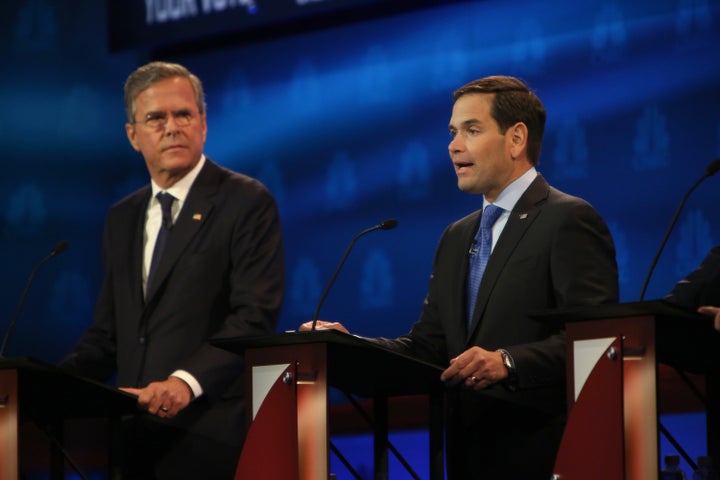
WASHINGTON -- The role of single-candidate super PACs has expanded exponentially in the 2016 presidential campaign. Candidates have become increasingly reliant and entwined with these committees, which can raise unlimited sums of money from most any source.
Created in the aftermath of the Supreme Court’s 2010 Citizens United decision and a subsequent lower court ruling, super PACs and other outside groups are supposed to operate independently from the candidates they support. The Citizens United decision made it possible for super PACs to collect unlimited corporate, union and individual contributions as long as they did not coordinate with candidates to determine how to spend the money.
Yet the real-world application of this new spending paradigm means that unlimited money groups are closely connected to single candidates, political party leaders and highly influential Washington lobbyists. Spending by outside groups like super PACs has already hit $64 million in the 2016 presidential race, with 90 percent of that total coming from single-candidate groups, according to data collected by the Center for Responsive Politics.
Since candidates and super PACs are forbidden from coordinating a large amount of activity with each other, they deploy a number of strategies to get around this ban and share information with the other party. Many of these tactics have been developed over the past three election cycles, although some of the most aggressive ones are new to 2016.
The new rules of super PAC coordination went into effect soon after the 2014 midterm elections. In December 2014, former Florida Gov. Jeb Bush announced that he would “actively explore the possibility of running for President of the United States." The hedged declaration stopped short of declaring that Bush was either an active candidate or was exploring a run, but rather suggested the possibility of one.
Some election lawyers say this allowed Bush to directly coordinate with a super PAC.
Bush used his get-out-jail-free statement to directly staff his Right to Rise super PAC and tour the country, raising over $100 million to spend on his presidential campaign. Nearly all the money Bush raised for the super PAC came in amounts above the legal $5,400-per-donor limit. Bush and Right to Rise coordinated strategy and materials for an extensive period before Bush declared his candidacy, which put up a firewall between the two parties.
“[W]e actually were able to do some filming before the wall went down, so we can do excellent creative,” Right to Rise director Mike Murphy said in a call with donors that Buzzfeed recorded. “We have some incredible stuff in the can that we shot with the governor.”
Bush’s super PAC involvement is just the most high-profile example of direct coordination in the supposed pre-candidate period. Republican presidential candidates, including Ohio Gov. John Kasich, former Hewlett-Packard CEO Carly Fiorina, Louisiana Gov. Bobby Jindal and former candidate Wisconsin Gov. Scott Walker, were all involved with the super PACs supporting them before they publicly entered the presidential race.
In Kasich's case, every ad aired by two groups that support his candidacy -- New Day Independent Media Committee and the New Day for America super PAC -- includes footage of the governor talking directly to the camera. Candidates aren't allowed to appear in footage shot exclusively by a super PAC or other outside group. However, the groups say they shot the footage prior to Kasich’s announcement that he was running for president. One of the ads can be viewed below.
Presidential candidates who hold federal office, including Sens. Marco Rubio (R-Fla.), Ted Cruz (R-Texas) and Rand Paul (R-Ky.), can't take advantage of the gaping coordination loophole Bush and other candidates have used. The coordination laws apply to them at all times they occupy federal office. Still, they've found other techniques to get video and other information to their super PACs.
Two groups back Rubio's candidacy: Conservative Solutions PAC, a super PAC, and Conservative Solutions Project, a nonprofit group that does not disclose its donors. Conservative Solutions PAC advertisements contain footage of Rubio on the campaign trail shaking hands with workers and giving a stump speech that could only have been filmed by his campaign.
How does a super PAC get access to this footage? Candidates believe they can share information with super PACs or other outside groups if that information is relayed in a public setting.
In September, for example, Rubio's campaign uploaded more than five minutes of b-roll footage -- snippets of film of the candidate with filler music playing -- to its Vimeo account. The practice of uploading b-roll footage for super PACs to “find” was widespread in the 2014 elections among congressional campaigns.
The b-roll footage from Rubio's campaign, along with a super PAC ad that used that same footage, can be viewed below.
Buzzfeed noticed that Cruz’s Senate campaign uploaded hours of footage to YouTube showing the Texas senator talking alongside his wife, father, mother and other family members. All of this is now available for outside groups to use if they need feel-good footage of Cruz with his family.
And Fiorina’s super PAC, CARLY for America, has uploaded over a minute of b-roll footage to its Vimeo account.
The Fiorina campaign also uses other public forums so its super PAC can handle much of the work normally associated with campaigns, including advance work at events and communications. The campaign posts her schedule online so the super PAC can track where she's supposed to be and arrive before her. Fiorina’s super PAC has also hosted events and conference calls featuring the candidate as a “special guest.”
Groups supporting Jindal have done the same. Jindal’s Believe Again super PAC has events already planned with the candidate in Iowa, up until the state’s caucus.
Democratic Party presidential front-runner Hillary Clinton also gets support from the Correct the Record super PAC through public channels. The group posts opposition research to its site that the Clinton campaign can reuse. The Clinton camp also pays a market rate to use the super PAC's non-public research. This essentially makes the super PAC a direct arm of the campaign, subsidized by six-figure contributions Clinton cannot raise directly.
Candidates and super PACs can also communicate through the press. The Cruz campaign did precisely this when anonymous Cruz advisors told Politico they were dismayed by the lack of advertising from the quartet of super PACs created to support him.
“I assume they’re waiting so their media buyers make the highest commission,” a Cruz advisor told Politico.
The strategically placed complaint apparently came about because one pro-Cruz super PAC worried about coordinating with the campaign. According to CNN, Keep the Promise I super PAC was planning a series of biographical advertising spots in South Carolina using the b-roll from Cruz' Senate account -- until lawyers stepped in to say that using the footage could run afoul of the coordination statutes. The footage can be viewed below.
One of the Cruz super PACs, Keep the Promise III, heard the call. The group made a tiny ad buy of $3,700 for 14 spots on the local CBS station in Davenport, Iowa, from Nov. 16-25.
At the end of October, a document detailing the struggling Bush camp's appraisal of its own campaign was leaked to different media outlets before U.S. News & World Report obtained a full version. The document did not paint a pretty picture of the campaign, but as The Washington Post’s Philip Bump noted, it did provide a blueprint for how his super PAC could aid his campaign.
“The ‘leak,’ like so many ‘leaks,’ may have been an intentional move to pass information to a pro-Bush super PAC,” Bump wrote.
This potentially strategic leak could have been prompted by the extensive interview that Right to Rise’s Murphy gave to Bloomberg Politics. In the interview, Murphy described that the pro-Bush super PAC viewed the race as a long slog into March. He further stated that the campaign would start airing “contrast” -- attack -- ads later in 2015. The full documents leaked to U.S. News & World Report painted a more urgent situation for the candidate in the early states, and seemed to urge immediate attacks on Rubio.
Less than two weeks later, The New York Times published a story citing sources who had been briefed on Right to Rise's lines of attack against Rubio, effectively describing the super PAC's ideas on how to campaign against him.
While there may not be any way to prevent super PACs and candidates from speaking through leaks to the media, some organizations have filed complaints against multiple presidential campaigns and their super PACs for allegedly violating coordination statutes -- and more are likely on the way.
Campaign finance reform groups Democracy 21 and Campaign Legal Center have already filed complaints against the campaigns of Bush, Walker and former Sen. Rick Santorum (R-Pa.) for coordinating with super PACs while stating that they were not candidates. The groups previously filed complaints against super PACs and campaigns for many of the practices taking place this year, including sharing and reusing b-roll footage.
The Federal Election Commission deadlocked on some of these key questions at a hearing on Tuesday, however, when it considered a request from Marc Elias, a lawyer for the two main Democratic congressional super PACs and the Clinton campaign.
Elias sought permission for the potential plans of his clients -- House Majority PAC and Senate Majority PAC -- to allow candidates to coordinate with super PACs prior to announcing their candidacy. Bush, a number of other Republican presidential candidates, and even one Republican Senate candidate, Florida Lt. Gov. Carlos Lopez-Cantera, have also taken similar actions.
FEC commissioners split along partisan lines about whether this, and other techniques used by current candidates, would be permissible. The commission also reached an impasse on whether or not a candidate could shoot footage or create other materials with a super PAC in a proposed pre-candidacy period -- as Bush, Kasich, Fiorina and others have already done.
The FEC did approve candidates' right to appear as "special guests" at fundraising events hosted by super PACs with as few as one or two donors present.
The possibility that the commission could decide against these tactics led Bush’s super PAC lawyer, Charles Spies, to file his own comments. Spies objected to whether the FEC could even consider imposing such rules, arguing the commission does not have “jurisdiction over private individuals who are not yet ‘candidates.’”
A divided FEC means that campaigns and super PACs with adventurous lawyers will continue to push the boundaries, as most presidential campaigns already have.
“Deadlocks by the FEC are viewed by many as a green light to go ahead and continue to break the law,” Campaign Legal Center counsel Paul Ryan says.
Those in favor of tough enforcement look to the Department of Justice to intervene in the most egregious cases. Earlier in 2015, the law enforcement agency prosecuted its first case of super PAC and campaign coordination.
Democracy 21 and Campaign Legal Center have already appealed to the Department of Justice to appoint a special counsel to investigate Bush’s creation of his super PAC, which they say involved a violation of the 2002 Bipartisan Campaign Reform Act.
